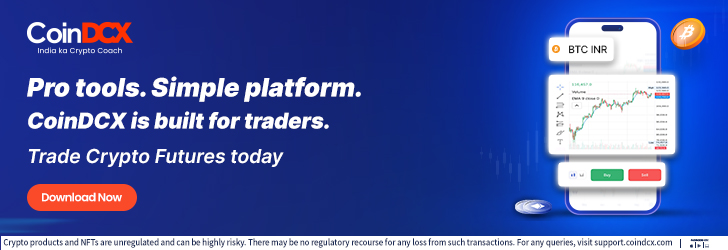Cryptocurrency adoption is increasing in India, and especially among traders who want to avoid the volatility present in assets such as Bitcoin and Ethereum. In this light, stablecoins like Tether (USDT) and USD Coin (USDC) are the most used. Both stablecoins offer a promised peg of 1:1 with the United States dollar.
In deciding which one to use, Indian traders can evaluate deeper issues than just the ‘promise of a dollar.’ Indian traders would want to analyze for liquidity, the regulatory framework, the cost of transactions, and other issues such as accessibility.
This article will present a breakdown of USDT vs USDC to Indian traders and answer the important question that kept you reading: Which stablecoin is most suited to your trading and investing needs?
What Are Stablecoins and Why Do They Matter?
- Stablecoins are cryptocurrencies that are attached to a stable asset (such as the U.S. dollar) to avoid the extreme volatility seen in assets like Bitcoin or Ethereum.
- For Indian traders, stablecoins provide several advantages:
- Hedge against Volatility: Protecting the profits made on trades when the market moves against traders.
- Cross-border transactions: Removing high banking fees is an advantage for quick transfers.
- Acting as Liquidity for Trading: Used as a common trading pair on exchanges.
- Access to USD Exposure: It allows Indian investors to purchase dollar (and dollar-pegged) coins without undergoing the long and expensive process of opening a foreign bank account.
- It is increasingly clear that stablecoins, such as USDT and USDC, have become essential trading tools for investors and traders as cryptocurrency adoption across India rises.
Why Stablecoins Matter for Indian Traders
Stablecoins such as USDT and USDC provide Indian traders a convenient way to:
Sometimes, without banking delays or restrictions, USDT and USDC provide easier access, movement, and hedging against volatility for Indian traders. Since INR deposits/withdrawals can be slow and exchanges have restrictions, stablecoins provide a solution for Indian traders to remain active in the global crypto marketplace 24/7.
The Indian Context: What Matters Most?
1. Liquidity and Accessibility
- Liquidity is at the top of the food chain for most Indian traders. USDT has an absolutely firm hold on the Indian market, most notably in P2P marketplaces where traders buy and sell Crypto directly, often using UPI or bank transfers. USDC trails in P2P adoption.
2. Costs
- USDT on Tron (TRC-20): Extremely low fees, fast transfer time.
- USDC on Ethereum (ERC-20): Higher fees unless using Polygon or Solana
- Because Indian traders can be cost-sensitive, USDT has a decisive advantage here.
3. Regulatory Environment
- The crypto regulation landscape in India is in flux. The government has instituted a 30 percent tax on profits and a 1% TDS on trades. Regardless of these measures, traders are still able to continue to use stablecoins in P2P. Compliance and transparency may come into play as the crypto ecosystem matures (which is a significant issue for USDC).
4. Risk Appetite
- High-frequency traders: Generally, they will gravitate towards USDT, as liquidity and low fees take precedence.
- Conservative traders: Will tend to favour USDC, given the regulatory footing, in comparison to USDT.
What Is USDT (Tether)?
Launched in 2014, USDT is the first and most utilized stablecoin. It has the greatest market cap and is the most-used trading pair across international exchanges. USDT is the most supported trading pair on almost all Indian crypto exchanges — including WazirX, CoinDCX, ZebPay, Giottus.
Pros of USDT:
- Largest liquidity in the world.
- Widely accepted and traded on international and Indian exchanges.
- Since it is so heavily traded in global and Indian crypto markets, USDT is ideal for trading quickly.
Cons of USDT:
- Concern over transparency surrounding the reserves backing USDT.
- USA and international controversies, and current regulatory scrutiny.
What Is USDC (USD Coin)?
USDC was launched in 2018 by Circle and Coinbase and has been recognized for a high level of transparency and regulatory compliance. USDC is highly audited the reserves are highly liquid, held in cash and short-term US treasuries.
Pros of USDC:
- Lots of trust and transparency.
- Usually, audited reserves with a greater level of regulatory compliance.
- Potentially wide adoption rate.
Cons of USDC:
- Lower liquidity than USDT.
- Lower trading pairs in Indian exchanges compared to USDT.
USDT vs USDC: Key Differences for Indian Traders
1. Liquidity & Trading Pairs:
USDT is typically considerably more liquid and is essentially the default trading pair on Indian exchanges. For the active trader, USDT provides quicker matching and lower slippage.
2. Trust & Transparency:
USDC has a more assured reputation with compliance and audited reserves, which gives more cautious investors confidence.
3. Adoption in India:
Most Indian exchanges and P2P markets are in favor of USDT, where USDC is penetrating slowly, but is not yet a preferred option.
4. Conversion to INR:
In P2P markets, USDT usually has a more favorable buy/sell spread and higher demand than USDC.
Which Is Better for Indian Traders?
- For traders who prioritize active trading with high liquidity and faster transfers, USDT is still the best practical option in India.
- On the other hand, if your priorities are safety, transparency, and long-term storage, USDC provides more assurances.
- There are many Indian traders who will hold both assets for this reason, using USDT to get in and out of trades quickly and the USDC for safer storage.
Final Thoughts
When it comes to USDT vs USDC, it comes down to a trade-off between liquidity and convenience (USDT) versus reliability and transparency (USDC). Indian traders should really look at their objectives: Are you a short-term trader looking to maximize your workflow, or a long-term investor looking to have less worry?
As the crypto market matures in India, we will likely see both USDT and USDC as part of the market. Maybe the best option is not to decide which is best, but to incorporate both of them—USDT as the currency for trading and transfers, USDC for long-term holds for potential yields and/or DeFi.






